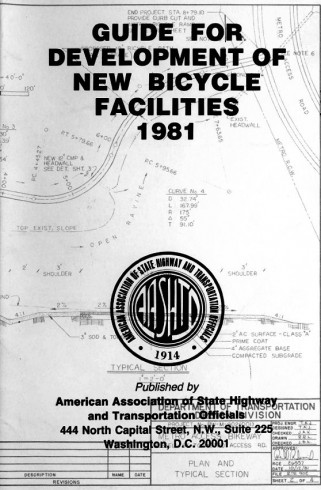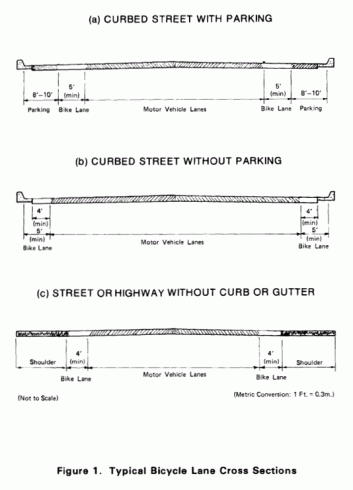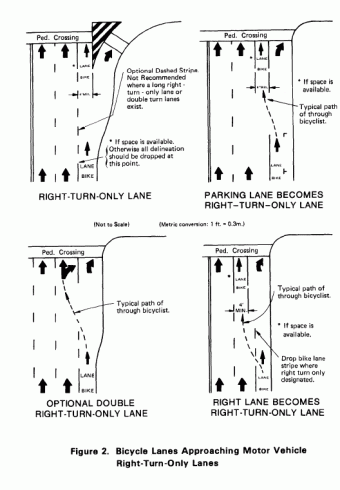In 1981, the American Association of State Highway and Transportation Officials published the first edition of its Guide for Development of New Bicycle Facilities.
It is copyrighted material, but I am publishing an excerpt under fair use provisions of copyright law, in response to comments which have been made about it.
This is what it said about bike lanes in the definitions section on page 2:
BICYCLE LANE (BIKE LANE) – A portion of a roadway which has been designated by striping, signing and pavement markings for the preferential or exclusive use of bicyclists.
This is what it said about bike lanes in the introduction on page 5:
Bicycle lanes, together with signs and pavement markings, can improve conditions in corridors where there is significant or potential bicycle demand by delineating the intended or preferred path of travel and by encouraging the separation of bicycles and motor vehicles. Bicycle lanes also help to increase the total capacities of highways carrying mixed bicycle and motor vehicle traffic.
And here is the section on design and application of bike lanes, from pages 11 through 14:
Bicycle Lanes
Bicycle lanes can be considered when it is desirable to delineate available road space for preferential use by bicyclists and motorists, and to provide for more predictable movements by each. Bicycle lane markings can increase a bicyclist’s confidence in motorists not straying into his/her path of travel. Likewise, passing motorists are less likely to swerve to the left out of their lane to avoid bicyclists on their right.Bicycle lanes should always be one-way facilities and carry traffic in the same direction as adjacent motor vehicle traffic. Two-way bicycle lanes on one side of the roadway are unacceptable because they promote riding against the flow of motor vehicle traffic. Wrong-way riding is a major cause of bicycle accidents and violates the Rules of the Road stated in the Uniform Vehicle Code. Bicycle lanes on one-way streets should be on the right side of the street, except in areas where a bicycle lane on the left will decrease the number of conflicts (e.g., those caused by heavy bus traffic). Under ideal conditions, minimum bicycle lane width is 4 feet 0 .2m).
However, certain edge conditions dictate additional desirable bicycle lane width. To examine the width requirements for bicycle lanes, Figure 1 shows three usual locations for such facilities in relation to the roadway.Figure 1 (a) depicts bicycle lanes on an urban curbed street where a parking lane is provided. The minimum bicycle lane width for this location is 5 feet (O.5m). icycle lanes should always be placed between the parking lane and the motor vehicle lanes. Bicycle lanes between the curb and the parking lane create hazards for bicyclists from opening car doors and poor visibility at intersections and driveways, and they prohibit bicyclists from making left turns; therefore this placement should never be considered. Where parking is permitted but a parking lane is not provided, the combination lane, intended for both motor vehicle parking and bicycle use, should be a minimum of 12 feet O.7m) wide. However, if it is likely the combination lane will be used as an additional motor vehicle lane, it is preferable to designate separate parking and bicycle lanes as shown in Figure 1 (a). In both instances, if parking volume is substantial or turnover is high, an additional 1 or 2 feet (0.3 or O.6m) of width is desirable for safe bicycle operation.
Figure 1 (b) depicts bicycle lanes along the outer portions of an urban curbed street where parking is prohibited. Bicyclists do not generally ride near a curb because of the possibility of debris, of hitting a pedal on the curb, of an uneven longitudinal joint, or of a steeper cross-slope. Bicycle lanes in this location should have a minimum width of 5 feet O.5m) from the curb face. If the longitudinal joint between the gutter pan and the roadway surface is uneven and falls within 5 feet O.5m) of the curb face, a minimum of 4 feet O.2m) should be provided between the joint and the motor vehicle lanes.
Figure 1 (c) depicts bicycle lanes on a highway without curb or gutter. Bicycle lanes should be located between the motor vehicle lanes and the roadway shoulders. Bicycle lanes may have a minimum width of 4 feet (0.2m), where the shoulder can provide additional maneuvering width. A width of 5 feet O.5m) or greater is preferable; additional widths are desirable where substantial truck traffic is present, where prevailing winds are a factor, on grades, or where motor vehicle speeds exceed 35 mph (55km/h).
Bicycle lanes tend to complicate both bicycle and motor vehicle turning movements at intersections. Because they encourage bicyclists to keep to the right and motorists to keep to the left, both operators are somewhat discouraged from merging in advance of turns. Thus, some bicyclists will begin left turns from the right-side bicycle lane and some motorists will begin right turns from the lane to the left of the bicycle lane. Both maneuvers are contrary to established Rules of the Road and result in conflicts.
At intersections, bicyclists proceeding straight through and motorists turning right must cross paths. Striping and signing configurations which encourage these crossings in advance of the intersection, in a merging fashion, are generally preferable to those that force the crossing in the immediate vicinity of the intersection. To a lesser extent, the same is true for left-turning bicyclists; however, in this maneuver, most vehicle codes allow the bicyclist the option of making either a “vehicular style” left turn (where the bicyclist merges leftward to the same lane used for motor vehicle left turns) or a “pedestrian style” left turn (where the bicyclist proceeds straight through the intersection, turns left at the far side, then proceeds across the intersection again on the cross street).
Figure 2 presents examples of details on pavement markings for bicycle lanes approaching motorist right-tum-only lanes. Where there are numerous left-turning bicyclists, a separate turning lane, as indicated in Part IX of the MUTCD, should be considered. The design of bicycle lanes should also include appropriate signing at intersections to reduce the number of conflicts. General guidance for pavement marking of bicycle lanes is contained in the MUTCD. Adequate pavement surface, bicycle-safe grate inlets, safe railroad crossings, and traffic signals responsive to bicycles should always be provided on roadways where bicycle lanes are being designated. Raised pavement markings and raised barriers can cause steering difficulties for bicyclists and should not be used to delineate bicycle lanes.



